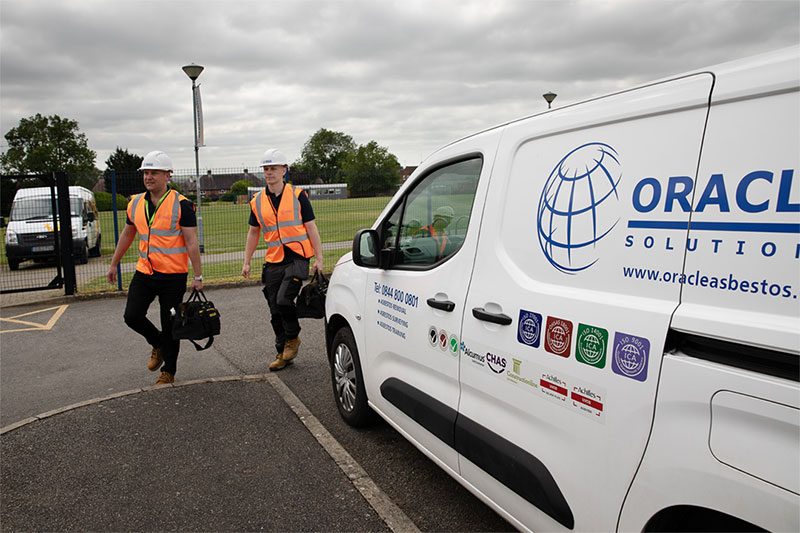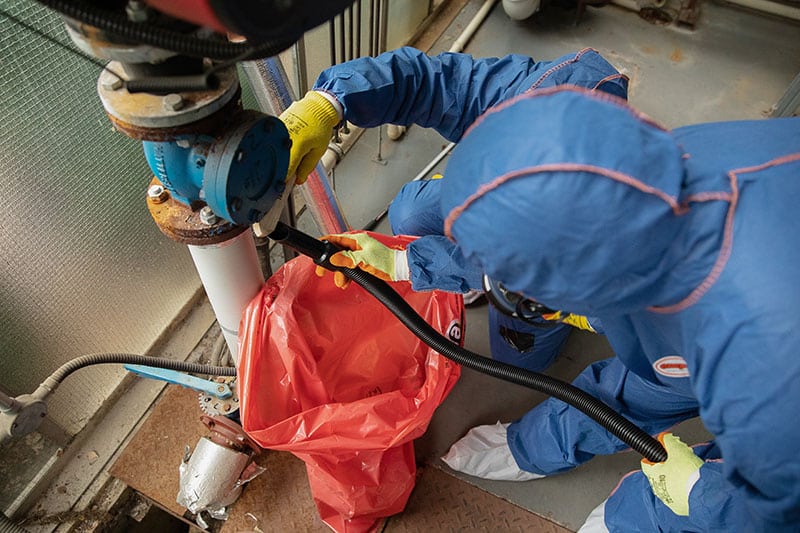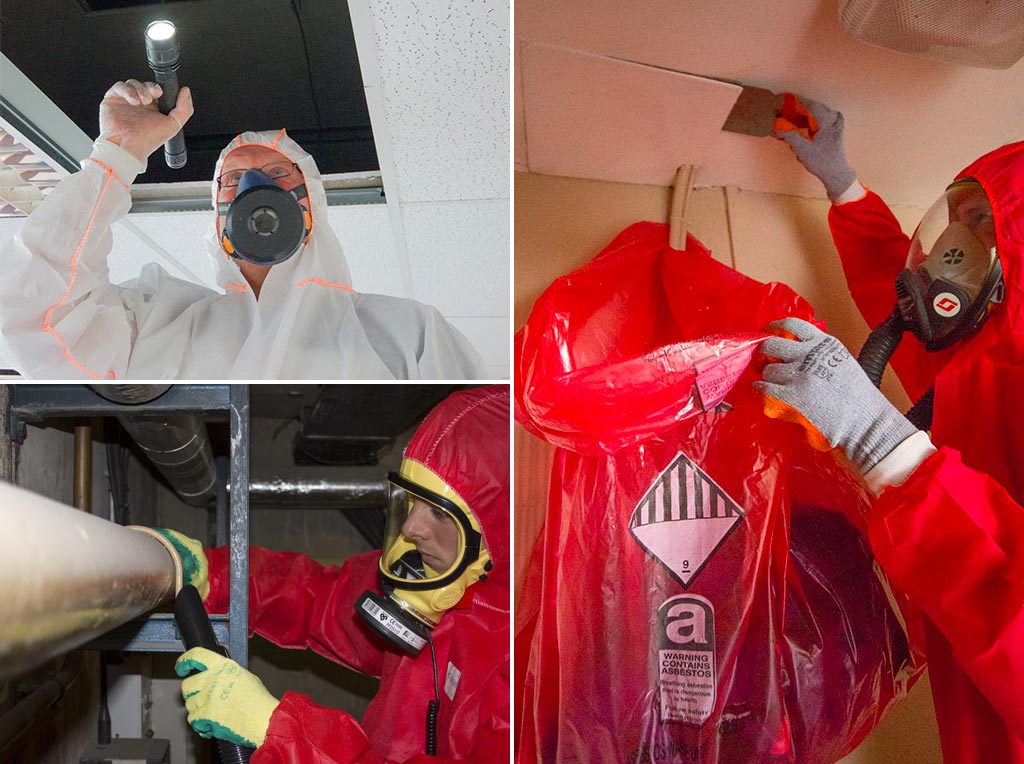What are risk assessments and plans of work in relation to licensed asbestos removal?
Risk assessments and plans of work both play a critical role in licensed asbestos removal – in other words, asbestos removal tasks that necessitate the individual who carries out the work holding a licence from the Health and Safety Executive (HSE).
Both these processes are requirements under the Control of Asbestos Regulations 2012 (CAR 2012). Regulation 6 of this legislation obliges employers to undertake a risk assessment to identify the risks of exposure to asbestos. Meanwhile, Regulation 7 requires employers to put together a written plan prior to work on asbestos being undertaken.

So, for individuals and organisations that are responsible for and directly involved in asbestos removal in some way – ranging from UK builders and other tradespeople to commercial property owners and dutyholders for schools and hospitals – it is vital to develop a strong understanding of the various requirements around these processes. This will help them comply with regulatory obligations, at the same time as ensuring the highest standards of asbestos safety.
What is a risk assessment in asbestos removal?
As the term implies, a risk assessment is a process of assessing risks – or, in this particular case, assessing a situation to identify the risks of exposure to asbestos.
An employer is required to carry out a suitable and sufficient risk assessment before they start any work that is likely to disturb asbestos. This obligation is set out under Regulation 6 of CAR 2012, which makes clear that employers must record any significant findings and put in place steps to prevent, or reduce, employees’ exposure to asbestos.
Why are risk assessments essential before asbestos removal?
With a risk assessment being a legal obligation prior to licensed asbestos removal work, this process is essential for avoiding legal penalties, as we explain further below.
However, the main reason why asbestos risk assessments exist, is the very real risk that asbestos poses to the safety of building workers and occupants alike. Every property from which asbestos may need to be removed will be different to the next, and the asbestos risks that may be presented to workers might be less than obvious at first glance.
Regulation 6, on risk assessments, should be considered alongside Regulation 11(1), which places a duty on employers to prevent their employees from being exposed to asbestos, so far as is reasonably practicable.
In some situations, it may not be possible to eliminate asbestos exposure – in which case, it must be reduced to the lowest level reasonably practicable. The risk assessment must identify how this can be achieved, in addition to determining whether there are any other risks in complying with this duty.
For example, if cables are rerouted to avoid the disturbance of asbestos-containing materials (ACMs), the risk assessment should consider what other risks the on-site workers would face, and what the overall risk to them would be.
It is essential to keep a lookout for more general risks, too, as is a requirement of Regulation 3 of the Management of Health and Safety at Work Regulations 1999.
What constitutes a comprehensive risk assessment for asbestos?
There are various components that make up an effective risk assessment for licensed asbestos removal work. The employer, or whoever else carries out the risk assessment on their behalf, will need to be competent to do it. They will also need to:
- Do the risk assessment prior to the work starting, allowing enough time to put in place appropriate controls
- Make sure the assessment is job-specific and considers the full scope of the work
- Establish the extent of potential risks and the people who could be impacted
- Identify the steps taken to eliminate the risk – or, if such elimination is not possible, to reduce the risk
- Record significant findings in writing, whether electronically or on paper
- Communicate significant findings to employees and anyone else who could be affected in a way that is understandable, as appropriate. This step is important for minimising the risks to these individuals or taking appropriate precautions to reduce/remove the risk prior to work beginning
- Review the assessment regularly, and update it as required.
Above all else, a risk assessment is about identifying hazards, and controlling the risks that such hazards pose. So, your own risk assessment will need to encompass such aspects as:
- How the asbestos removal work will be undertaken, and the expected scale and duration
- The types of asbestos, and the results of any survey or analysis, or a statement that assumes the presence of asbestos
- The type, quantity, amount, means of attachment, and condition of the on-site ACMs
- The anticipated level of asbestos exposure
- The controls that will be used to lower exposure, such as controlled wetting or local exhaust ventilation
- Procedures for decontaminating tools, equipment, and personal protective equipment (PPE)
- How asbestos waste will be managed and disposed of at a site that holds an appropriate licence for this
- Emergency procedures
The HSE makes available a comprehensive publication, entitled Managing and working with asbestos, which provides more detailed information on CAR 2012 compliance, including in relation to risk assessments and licensed asbestos removal. A free PDF copy of this book, under the L143 series code, is downloadable from the HSE website.
What is a plan of work in licensed asbestos removal?
For any work that involves asbestos – including licensed asbestos removal – there is a legal obligation, under Regulation 7 of CAR 2012, to draw up a written plan of how the work is to be carried out, prior to that work starting. This is referred to as the “plan of work”, although it is also sometimes called a “POW”, “plan”, or “method statement”.
The plan of work will need to set out specific details of the work, as well as the appropriate actions to control risk and prevent harm. Employers must also make sure their employees follow this POW.
Suitable and sufficient plans of work are a legal requirement and a licence condition for any licensable work with asbestos, such as licensed asbestos removal.
As a condition of their licence, a licensed contractor is required to notify the appropriate licensing authority, a minimum of 14 days prior to each job. A suitable and sufficient POW needs to have been prepared by the time of notification – otherwise, the enforcing authority will reject the notification as invalid.
How does a plan of work ensure safe asbestos removal?
A suitable and sufficient plan of work will serve as a practical and useful document, setting out a safe working method for employees to follow when carrying out licensed asbestos removal work. It is also a vital tool for senior managers/directors, as it shows that they have taken account of significant site risks, and put together a specific job plan to address them.
A POW for a licensed asbestos removal job will need to address not only the removal itself, but also measures for safely containing and disposing of the potentially dangerous substance.
With the information that the POW provides on such aspects of the licensed asbestos removal job as the specific safety procedures, equipment, and procedures for protecting workers and the environment, this plan will greatly help ensure the highest standards of asbestos safety.
What should be included in a plan of work for asbestos removal?
Your plan of work for licensed asbestos removal should include the following information:
- The nature and probable duration of the work
- The number of people involved in the work
- The address and location where the work is to be undertaken
- The methods that will be used to remove the ACMs
- The methods that will be used to prevent or reduce exposure to asbestos
- The types of equipment, including PPE and respiratory personal equipment (RPE)
- Where necessary, the site layout, a description of the location and nature of the asbestos present, and which ACMs will be disturbed by the work.
It is vital to ensure the plan of work you write up is customised in accordance with the specific site conditions and the types of ACMs involved.
Who is responsible for conducting risk assessments and creating plans of work?
Regulation 6 of CAR 2012 requires employers to conduct a risk assessment to identify the risks of someone being exposed to asbestos as a consequence of the work that is to be carried out. It doesn’t necessarily have to be the employer themselves who undertakes the risk assessment; someone else could do this on their behalf.
Whether it is the employer that performs the risk assessment, or someone else, they will need to be competent to do so. This will include them having adequate knowledge, training, and expertise in understanding the risks that asbestos poses. They will need to know how the licensed asbestos removal job is likely to disturb the ACMs, as well as understand the requirements of CAR 2012.
Similarly, when it comes to creating the plan of work, the relevant part of CAR 2012 – Regulation 7 – sets out a requirement for the employer to do this. The plan will need to be written up by a suitably competent person, after a visit and full appraisal of the site.
However, it is crucial as part of this planning process to engage in detailed discussions with others. Stakeholders such as the dutyholder under CAR 2012, the owner of the given buildings, and/or the employees who will directly supervise and/or carry out the asbestos removal work, are likely to be able to provide valuable input to support the creation of the POW.
What are the consequences of failing to comply with asbestos safety regulations?
There can be extremely serious health implications for those who are exposed to asbestos. The inhalation or ingestion of loose asbestos fibres – as can be released into the air in the event of disturbance to ACMs – can heighten the risk of exposed individuals developing a potentially fatal asbestos-related disease, such as mesothelioma or asbestos-related lung cancer, many years or even decades later.
However, you also shouldn’t underestimate the possible legal and financial repercussions of violating asbestos safety regulations such as CAR 2012. As we have previously written about, breaches of asbestos law can lead to fines running into tens of thousands of pounds, and even prison sentences.
You only need to consult our industry news section to see real-life examples of the enforcement actions and penalties that could arise if you fail to properly assess risks and plan asbestos work. Consider, for instance, the case of two construction-company directors being fined after an unsafe asbestos removal operation at a site in Oldham, or this story involving widespread asbestos failures that led to a financial hit of more than £100,000.
Conclusion: safeguarding health and safety through rigorous planning and assessment
Hopefully, this guide will have helped make clear to you the critical importance of risk assessments and plans of work in licensed asbestos removal. Here at Oracle Solutions, we strongly encourage all stakeholders to prioritise these processes to protect workers, occupants, and the general public from the dangers of asbestos.
Are you on the lookout for the licensed and accredited asbestos services that could assist you with the management of ACMs on your own site? If so, please don’t hesitate to contact our team for a fast and free asbestos quote; you can call us today.

Written by Brendan Coleman
Brendan Coleman, with decades of experience in the asbestos industry, is a dedicated Quality Manager. Certified as a surveyor and analyst, he is adept in operations and quality management with a keen focus on HSE compliance. His expertise is pivotal in maintaining high safety and efficiency standards. Brendan ensures our UKAS accreditation requirements are consistently met and exceeded, upholding stringent standards in asbestos remediation. His commitment to enhancing quality and customer satisfaction makes him an essential advisor in asbestos management.


